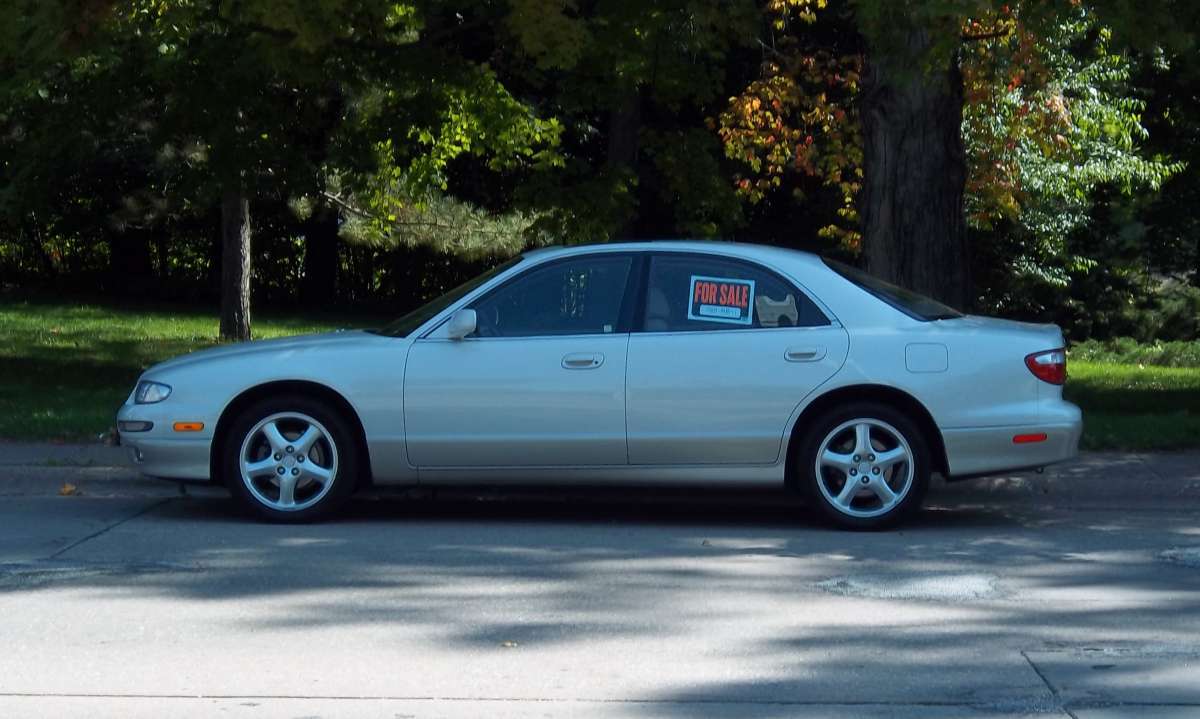
In the late 1980s and early 1990s, Japanese automakers broadened their lineups with luxury divisions, to supplement their entry- and middle-class focused fare. Acura in 1986; Lexus in 1989; and Infiniti in 1990. Mazda also had a plan for a new luxury marque to be called Amati. What debuted as the 1995 Mazda Millenia was originally intended to be the first of several Amati models exported to North America by Mazda. For better or worse, it didn’t happen, and Mazda’s answer to Lexus never happened.
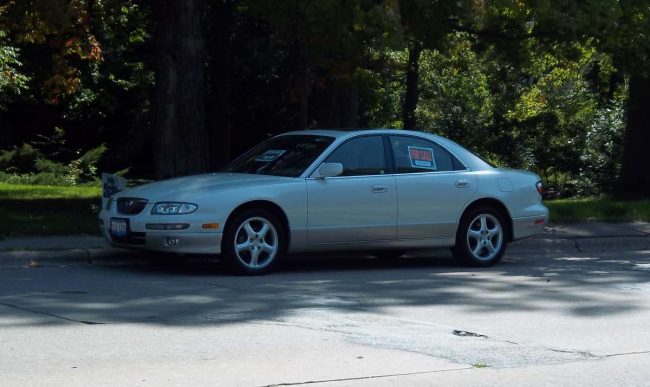
Mazda was on a roll in the ’90s. The 1989 Miata had returned the small, sporty roadster to relevance–so successfully, in fact, that within a few years Mercedes-Benz, BMW and Porsche all had two-seaters on their drawing boards. The 323/Protégé was a competent little compact (My friend Tony LaHood had a Protégé 5 he still misses), and the mid-size 626, while perhaps not as popular as the Accord or Camry, still held its own. My boss circa 2002 got a brand new 626 in a metallic bronze with tan leather. It was a nice looking, comfortable midsizer; I drove it several times. With production (at least for North America) of the Japan-built 929 luxury sedan set to end in 1996, Mazda began preparing to launch its own luxury brand: Amati.
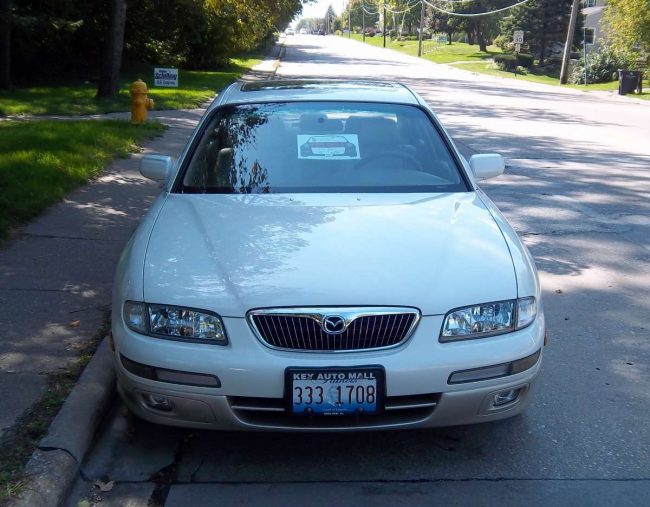
Amati was going to be Mazda’s Lexus. The brand was to be positioned a cut above the regular Mazda line to compete with not only other up-and-coming premium Japanese luxury brands, but naturally also with Audi, BMW and Mercedes-Benz. Mazda had long used various sub-marques for its home-market vehicles (more info here), including the somewhat Russian-sounding Autozam, Efini, Eunos and M2. The Eunos 500 was what would have been the first Amati model; in the wake of Mazda’s eleventh-hour scrapping of Amati, it came to the U.S. as the Millenia instead.
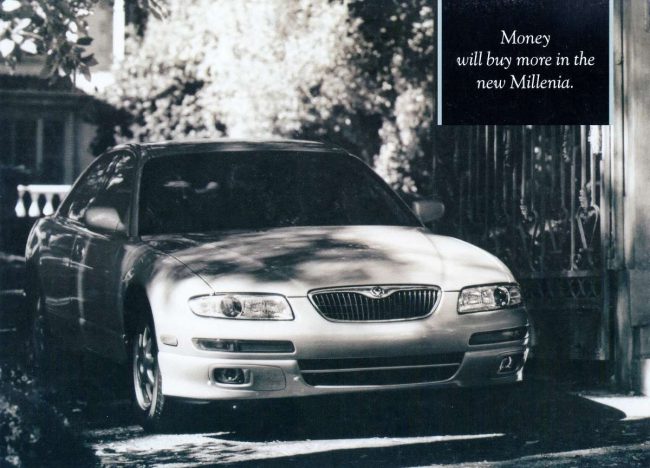
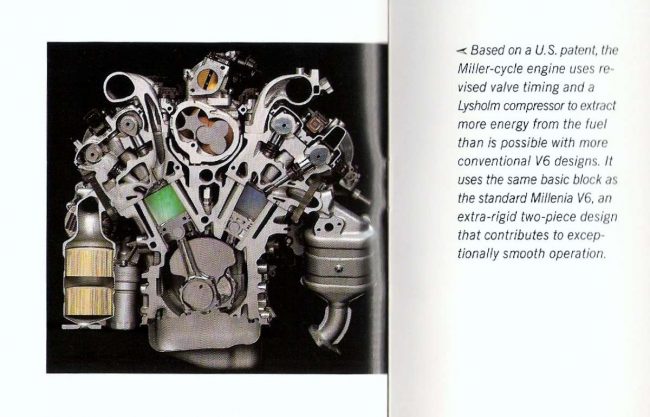
While the Miller-cycle V6 shared its two-piece block with its less exotic 2.5-liter cousin, it utilized a Lysholm compressor. The Miller cycle uses a delayed closing of the intake valve during the compression stroke which allows, among other things, a higher compression ratio. It’s essentially the same as the modern Atkinson cycle engine used in some hybrids, including the Prius. However, the Miller-cycle version compensated for the Atkinson’s loss of power density (which is masked by a hybrid’s electric motor) with a compressor that boosted power by forcing a greater fuel/air mixture into the cylinders. Directly driven by the engine, the compressor provided instant boost when called upon.
Another feature of the Miller-cycle was twin air-to-air intercoolers, which lowered air intake temp to take full advantage of the Lysholm compressor’s charge. As with the 2.5, the 2.3 was mated to a four-speed automatic transmission.
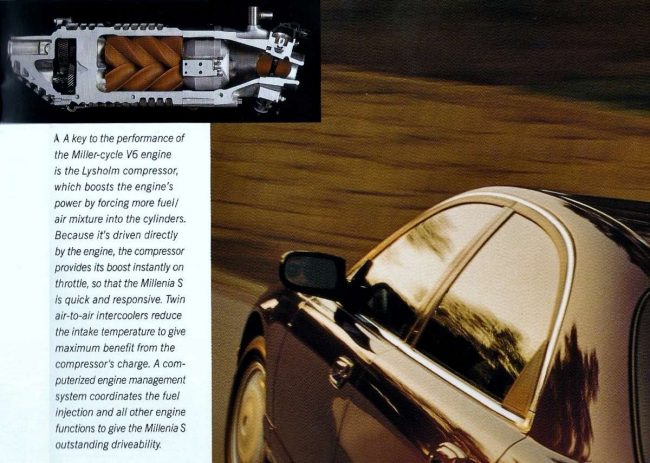
According to Mazda, the Miller-cycle V6 was about 50% more powerful than conventional engines of similar size, a claim substantiated by the Millenia’s engines themselves. The 2.5-liter (2,497cc) version produced 170 horsepower @ 5800 rpm and 160 lb-ft of torque @ 4800 rpm. The 2.3-liter Miller-cycle, while smaller, got a healthy bump up to 210 hp @ 5300 rpm and 210 lb-ft of torque @ 3500 rpm. Not bad at all for 1995, which was well before the dawn of 300-horsepower Impala LTs.
In addition to the special engine, S models received standard traction control and 16″ alloy wheels, shod with low-profile P215/55 all-season radials.

Amati may never have gotten off the ground, but there were numerous ways to tell that the Millenia wasn’t originally intended to be a plain old Mazda–not even a fancier one. All Millenias benefited from higher levels of fit, finish and assembly quality. Mazda happily touted that most panel gaps measured “a miniscule 3.5mm, even narrower than found on many renowned European cars,” according to the 1995 brochure.

The interior was quite a nice place to be. Standard Millenias had “luxurious cloth upholstery” but offered optional leather as expected. Leather seating was unsurprisingly standard on the Millenia Leather and Millenia S models.
Riding a 108.3″ wheelbase, and with an overall length of 189.8″, the Millenia was not quite as big as the soon-to-be-departed 929, but still pretty good sized for a Mazda. In its debut year, the Millenia was priced from $27,525.
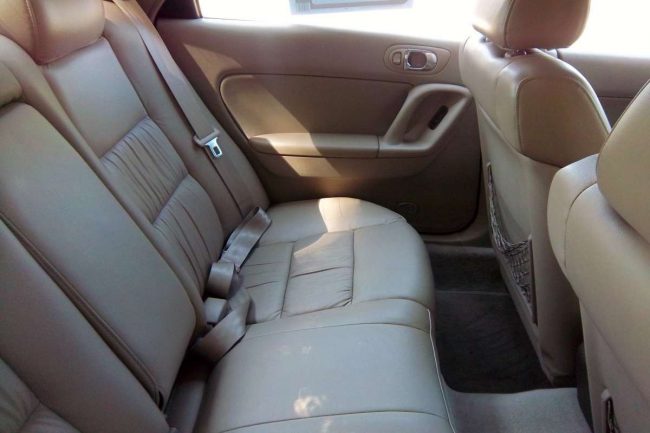
The Millenia’s seating bespoke as much attention to detail as did its exterior. Looking over this 2000 S, I could see it as a sportier alternative to a contemporary ES300. But as nice as it was, without a luxury nameplate it just wasn’t going to do as well with the country-club set. But for those who just wanted a nice car, the Millenia was a pretty interesting choice.
Back around 2002, the receptionist at my Uncle Chris’s law firm got in an accident with her Mark VIII and bought a brand new Millenia to replace it. Despite her Lincoln preference–at the time she had had her ’93 Mark VIII and her husband had a navy blue ’89 Mark VII LSC and a silver ’98 Town Car–she just loved that Millenia.

All Millenias were well-equipped, with standard ABS; power mirrors, windows and locks; tinted glass; fog lights; an eight-way power driver’s seat; anti-theft alarm; automatic climate control; a five-speaker AM/FM/cassette stereo with power antenna; a power-operated tilt wheel; and a rear-window defogger.
Millenia Leather and Millenia S models featured standard leather seats and leather-wrapped shift and handbrake levers, a four-way power passenger seat, a power-operated moonroof and keyless entry.

I found our featured Millenia just down the street from my condo wearing a “For Sale” sign back around Labor Day of 2012. It had been sitting for a couple of weeks, but I finally managed to pull over and get some photos one afternoon. It was essentially in showroom condition. It must have been well-taken care of, since around here most Mazdas over 10 years old have moderate to serious rust, especially around the rear wheel wells. Not this one, though.

And it was even an S model with that intriguing Miller-cycle V6 under the hood. It’s certainly the Millenia to have, with its extra power, standard everything and nicer five-spoke alloys.

These were nice-looking cars, and it wasn’t until I spotted this one that I realized it was the first I’d seen in years. Ironically, about a week later I was walking around the neighborhood when I came upon a late-model “facelifted” Millenia, in dark green–and with the more typical wheel-well rust.
Since then, I don’t recall seeing another one. Wonder how many are still running around now?







12 Comments
I wonder how the Miller cycle engine lasted in service. That sounded like a lot of complication and a lot of torque for a Japanese front drive transaxle. I remember hearing that the 626 had shifted to the Taurus automatic. I believe around then Nissan was pushing Mazda and Ford out of JATCO so Mazda had to start doing inhouse or rely on Ford.
Describing 90’s Mazda’s and not mentioning the FD. Harumph and derisive snort.
Nice find. I liked these, but wasn’t in the sedan phase of my life at the time. As with Wankel or Skyactive, Mazda has never been afraid to break the mold.
I owned a 1999 Millennia S exactly like the one on these pics as my first car some years ago. Mine was a well-loved example with about 90,000 miles on it when I purchased it. Gorgeous car, very comfortable and drove nicely. Though it was on a FWD architecture, the relatively low center of gravity, smaller engine, low hood and cowl and wife tires made it a real pleasure to drive in the twists. I took it, with 4 friends, to a camping trip in the Eastern KY mountains and wow, was it a blast to drive hard into all the switch-backs in the hills. My passengers all complained that I drove way too fast around those turns for their pleasure, but I took it as a sign of a well-sorted chassis.
It did have some notorious mechanical and electrical bugs that afflicted nearly every single car that came off the assembly line. In particular, an O2 sensor would fail around 100,000 miles and cost around $800-900 to replace. The seat-heaters on mine were already broken and non-functional by the time I bought mine.
The fit and finish was excellent indeed. Small, consistent panel gaps and decent color-matching on interior trim was to be expected. There were some hard plastics but they never became discolored in the sun like many other contemporary vehicles had. The leather on the steering wheel and the shit knob was quite nice. It was a joy to have that car.
hi, the seat heaters are controlled by the thermostat temp
I remember a fairly new “rookie” salesman buying a used one of these when he got his first “big” check from selling cars, Pontiacs and GMC’s too, so so much for loyalty, but I remember advising him against it, but he still bought it, and I remember seeing him on the side of the turnpike with the hood up and how incredibly pissed he was….
He should have kept the 86 Century he was driving before.
If these were so great, why didn’t they have the swing vents?
They didn’t?! Never knew that. I never drove one. I remember the 626s had it. I test drove a black one with light gray leather in 2001, noticed that, pushed the button, and went “Cool!”
My second thought was, why the hell don’t all cars have this?
Well, according to my googling the Millenia did not have the feature, and I see no SWING button between the center vents. My reaction to it on the 626 was similar. That generation of 626 came out a year earlier than the Millenia too. [Insert obligatory joke about the button having something to do with wife-swapping here]
My only recollection of the Millenia was some guy stating that the Miller cycle engine was “an expensive complicated engine that saved a little gas.” But obviously they were aspiration in a way that Maximas and even Diamantes once were.
I always thought these and the 92 ES300 were the nicest looking FWD sedans, with the possible exception of some Audis. What other 90s FWD sedan looks so good in white?
Oldsmobile Aurora, Cadillac Seville STS, Bonneville SSEi……
I really liked the Bonneville SSEi in white with the white wheels and saddle tan leather…
Mazda has never had the quality inherent in Toyota. Example: I bought a new ’83 GLC wagon & my buddy bought a new ’83 Toyota Corolla wagon. My car blew a freeze plug at 500 miles and the motor dropped a rod at 90K miles. His Corolla went over 220K miles problem free, before he crashed it. Of course, I could go on about the short nose Miata motors and the rotary engine oil consumption. Not to mention sky active motor issues. And yes, some Toyotas have had problems. But overall, Mazda has a terrible track record for poor reliability, low quality materials and poor overall build.